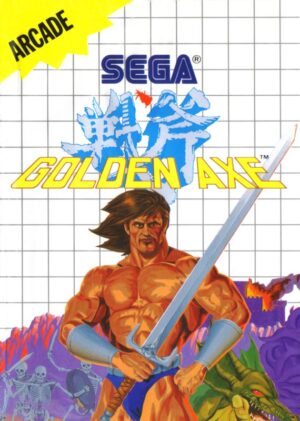Retro Replay Review
Gameplay
Sword of Sodan delivers a pulse-pounding combat experience that challenges players to master a variety of sword-slashing and jumping maneuvers. From the first moment you step into the arena, the weight and momentum of your blade feel tangible—each swing demands precision and timing. You’ll quickly learn that brute force alone won’t carry you through all eleven treacherous levels; instead, you must combine attacks, leaps, and strategic retreats to survive hordes of undead minions and monstrous guardians.
(HEY YOU!! We hope you enjoy! We try not to run ads. So basically, this is a very expensive hobby running this site. Please consider joining us for updates, forums, and more. Network w/ us to make some cash or friends while retro gaming, and you can win some free retro games for posting. Okay, carry on 👍)
The level design alternates between claustrophobic indoor corridors and sprawling outdoor battlegrounds, ensuring that no two encounters play out the same way. Narrow castle hallways force you to inch forward cautiously, whereas open fields give you room to charge and fence with enemies across the screen. An action-replay feature, rare for its time outside of sports titles, allows you to review key moments in battle and refine your tactics, lending a training-ground feel to the adventure.
Puzzle elements woven into certain stages add a welcome layer of variety. Locked gates, pressure plates, and hidden levers challenge you to think on your feet while undead archers rain arrows from above. The pacing strikes a careful balance, alternating between fast-paced brawls and slower, more methodical exploration. While some foes can feel repetitive after extended play, the overall combat system remains satisfying thanks to its responsive controls and the thrill of narrowly escaping a fatal blow.
Graphics
Visually, Sword of Sodan stands out chiefly for its enormous, highly detailed sprites—a hallmark of Søren Grønbech’s technical ambition, reminiscent of his earlier work on Datastorm. Characters tower over the background, their armor plates, flowing capes, and sinewy muscles rendered with surprising clarity. These oversized figures give the game a cinematic scale, making every encounter feel larger than life.
Backgrounds and environmental details are modest by today’s standards but were a major selling point in their era. Castle walls show weathered bricks, torches flicker with animated flames, and forests rustle with pixelated foliage. While parallax scrolling is limited, the game compensates through varied palette swaps and atmospheric fog effects in outdoor stages, adding depth without taxing the hardware.
Digitised sound and speech snippets further enhance immersion. Enemy growls, clangs of steel on steel, and the hero’s war cries punctuate battles, making each clash feel more visceral. Though these samples are brief and sometimes loop awkwardly, they remain impressive feats of audio engineering for the platform. Overall, the graphics strike an effective balance between technical showmanship and functional clarity, ensuring you always know where friend and foe stand.
Story
The tale of Sword of Sodan unfolds in a dark fantasy realm ruled by the malevolent necromancer, Zoras. You assume the mantle of a fallen hero or heroine—your father slaughtered by Zoras’s undead army—on a quest for vengeance. While the overarching narrative is straightforward, it provides just enough motivation to charge into battle and confront wave after wave of spectral adversaries.
Storytelling is delivered sparingly through brief cutscenes and on-screen text, allowing the gameplay to take center stage. You learn of hidden alliances, cursed artifacts, and past betrayals as you progress, but the game resists bogging you down with exposition. Instead, each new level’s aesthetic and enemy roster convey the creeping dread of a world overshadowed by necromantic power.
Despite its minimalist approach, the narrative gains emotional weight in key moments—finding your father’s shattered sword, witnessing the corruption of once-honorable knights, and finally facing Zoras atop his obsidian throne. These beats are punctuated by stirring music and digitised voice lines, making the climax feel like a true reckoning rather than just another boss fight.
Overall Experience
Sword of Sodan remains a memorable title for enthusiasts of retro action games and those curious about early technical innovations. Its combination of large, distinctive sprites, varied level design, and an action-replay system set it apart from contemporaries. While some mechanics may feel dated—collision detection can be unforgiving, and enemy variety tapers off in later stages—the core combat loop never loses its appeal.
For newcomers, the game offers a stern but fair challenge. Each level introduces new enemy types and environmental hazards that keep you on your toes, and the thrill of finally mastering a tricky sequence of moves is as satisfying now as it was upon release. The audio-visual presentation, though primitive by modern standards, exudes charm and showcases the ambition of its developer.
Whether you’re motivated by nostalgia or by a desire to experience early examples of technical daring, Sword of Sodan delivers a robust adventure. Its streamlined story, robust combat mechanics, and bold graphical choices ensure that, despite some rough edges, the quest to dethrone Zoras is a rewarding journey for any action-oriented gamer.
 Retro Replay Retro Replay gaming reviews, news, emulation, geek stuff and more!
Retro Replay Retro Replay gaming reviews, news, emulation, geek stuff and more!









Reviews
There are no reviews yet.